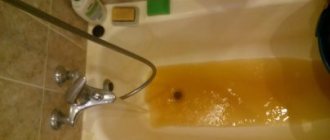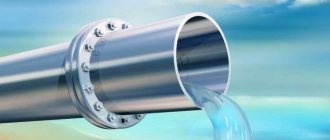The essence of drainage
Housing and communal services receipts contain a lot of items such as cold or hot water consumption, heating services, contributions for major repairs or sanitation. The last item of expense in the bills appeared relatively recently, although the service itself was provided to residents. The water used by residents was disposed of through the sewer system, as they still do today, but the service is called in a new way - sewerage.
In fact, sewerage and sewerage are one and the same service, but water supply is no longer included here. Water supply involves the supply of water to the home, and drainage involves the disposal of the used resource.
Wastewater is delivered through sewer systems to treatment facilities and is subjected to repeated disinfection and purification. This is a complex, multi-stage, labor-intensive and expensive process, which is why every city resident living in an apartment with centralized drainage pays for these services monthly.
Storm drainage system in the water protection zone
For the purpose of classifying a centralized storm water drainage (sewage) system, intended for the removal of surface wastewater from the territories of a settlement or urban district, as a centralized sewerage system of settlements or urban districts in accordance with paragraph 8 of the Rules for classifying centralized sewerage (sewage) systems as centralized sewerage systems of settlements or city districts approved by Decree of the Government of the Russian Federation of May 31, 2021 N 691, an organization that carries out wastewater disposal and is the owner or other legal owner of the centralized sewerage system (sewage system) (an organization that carries out wastewater disposal and is the owner or other legal owner of engineering structures intended for the discharge of wastewater into a water body - if the owners or other legal owners of individual objects of the centralized water disposal (sewage) system are different persons), submits to the body authorized to approve the water supply and sanitation scheme , copies of one or more available such organization of documents confirming that the centralized water drainage (sewage) system is a centralized storm water drainage (sewage) system intended for the removal of surface wastewater from the territory of a settlement or urban district, from among the following documents:
1) design and (or) executive documentation for objects of a centralized water disposal (sewage) system;
2) acts of commissioning of centralized sewerage (sewage) system facilities, permits for the commissioning of such facilities or acts of acceptance of completed construction of centralized sewerage (sewage) system facilities;
3) technical and (or) technological regulations for the operation of centralized water disposal (sewage) system facilities;
4) acts of technical inspection of objects of the centralized water disposal (sewage) system;
5) technical (cadastral) passports of objects of the centralized water disposal (sewage) system;
6) inventory cards for recording fixed assets, filled out in relation to objects of the centralized water disposal (sewage) system;
7) title documents for objects of a centralized water disposal (sewage) system.
How are fees calculated?
In the course of human activity, a lot of waste remains that requires proper disposal without threatening the environment and people themselves. The calculation of the service consists of the cost of several items:
- removal of used cold and hot water supply resources;
- transportation of used water to treatment facilities;
- processing and high-quality cleaning;
- proper maintenance of sewer lines.
To correctly calculate the payment for sewerage, you need to perform a number of actions:
- The tariff for the disposal of cold and hot water is multiplied separately by the actual volume used.
- The volume is determined using metering devices by subtracting the previous meter reading from the current one.
- Both results are added to obtain the final result for the drainage service.
A centralized water disposal system is a complex complex that includes recycling and treatment facilities, reservoirs and all kinds of water pipes, cleaning reagents and other installations necessary for the complete disinfection and purification of water resources.
Types of drainage systems
In total, there are three different types of drainage systems for an object or settlement: all-alloy , separate and semi-separate systems.
1 The common sewage system has one drainage network designed to drain all types of wastewater: domestic, industrial and atmospheric (rain/melt water).
During heavy rains, part of the mixture of domestic, industrial and rainwater is discharged into the water body through special structures on the network - storm drains .
All-alloy sewerage system KOS - sewage treatment facilities; SPS - sewage pumping station; L - storm drain
+ Pros:
- Shorter length of pipelines compared to other systems;
- Reducing the number of facilities on the network;
- Significantly lower operating costs compared to a complete separate system.
— Minuses:
- Large pipe diameters, hence an increase in capital investments for network construction;
- High cost of pumping stations and treatment facilities;
- Discharge of a mixture of domestic, industrial and rainwater into water bodies during rainstorms.
2 Separate drainage system is divided into complete and incomplete
> A complete separate system has two closed drainage networks: one for the removal of domestic and industrial wastewater, the second for the removal of rainwater.
> An incomplete separate system differs from a complete one in that rainwater is drained by an open network, i.e. street trays, ditches and ditches.
Ditch - a drainage ditch installed on both sides of the road
Separate sewage system WWTP - sewage treatment plants; SPS - sewage pumping station; VOCs - local treatment facilities
Rainwater through a separate system can be discharged into a water body either without treatment or with treatment.
+ Pros:
- When cleaning rainwater, this system minimizes damage to the environment
- The big advantage of a separate sewerage system is the established, well-developed construction technology. Typically, the construction of drainage networks using such a system is carried out in two stages: at the beginning, an industrial and household network is installed, and then, as the city develops, a closed rainwater network is installed).
- No separation chambers
- Relatively low cost of treatment facilities
— Minuses:
- Higher construction cost compared to a common alloy system
3 The semi-separate sewerage system has two drainage networks: industrial and domestic and rainwater. At the intersections of these networks, separation chambers are installed, the purpose of which is to discharge the excess part of the runoff into the reservoir during heavy rains.
Thus, only the most contaminated part of storm wastewater enters the industrial and household network through separation chambers.
Semi-separate sewerage system WWTP - sewage treatment plant; SPS - sewage pumping station; rk - separation chamber
+ Pros:
- No discharge of industrial, domestic and heavily polluted rainwater wastewater into the reservoir;
- Cleaning the most contaminated part of rainwater runoff
— Minuses:
- Highest construction cost compared to other systems
Separately, there is also a combined drainage system : this is a system in which a populated area in one part has a general drainage system, and in the other a completely separate one. This is typical for most large Russian cities.
The text was written based on a lecture by Doctor of Technical Sciences, Prof. M.I. Alekseeva
How to reduce wastewater disposal costs
Unscrupulous managers sometimes artificially inflate the cost of sanitation services. To avoid such situations, the utility consumer should do the following:
- control invoices and amounts issued for payment;
- demand recalculation if the amount in the payment turned out to be incorrect;
- if there are no IPUs, then install them on all resources where necessary;
- use traditional water saving methods.
There are a lot of different calculators for correctly calculating sewerage fees. To get the result, you need to enter your data and wait for the calculator to calculate.
Is it possible not to pay for sewerage?
Payment for wastewater disposal is included in the list of mandatory utility payments, such as water supply, heating or gas supply, etc. The service is provided by the water utility, and therefore it must be paid monthly. In fact, residents pay to ensure that the used water is not poured into natural reservoirs in a dirty state, threatening the environment, but is properly purified.
If the user evades payments, then:
- Penalties are charged for late payment of utility bills. Payments for housing and utilities must be made by the 10th day of the month following the reporting month.
- If there is a large debt for sewerage, the resource supplying organization may file a lawsuit for forced collection of the debt. If the court rules in favor of the plaintiff, then the bailiffs may seize the debtor’s accounts, property, or send the employer a demand to deduct part of the salary on a monthly basis to pay the debt.
- Travel outside the Russian Federation may be prohibited.
Sewage must be paid for in the same way as other utilities, otherwise the defaulter faces sanctions from the accrual of penalties and judicial collection.
Sewerage
Modern Moscow sewerage is a complex system of engineering structures, the reliable and efficient operation of which is one of the most important components of the sanitary and environmental well-being of the city.
The public sewerage system of Moscow in its historical development has developed as a separate one. It receives only domestic, municipal and industrial wastewater. Surface wastewater is discharged through an independent drainage system. All domestic and industrial wastewater entering the Moscow city sewerage system through a network of pipelines, canals and collectors with a diameter of 125 mm to 4.5 m undergo a full treatment cycle at treatment facilities with a total design capacity of 5.5 million m3/day . The total length of the city's sewer network is more than 9,058 km.
The main direction of sewer pipelines is oriented to the south and southeast of the city, in the direction of the flow of the Moscow River, which is determined by the terrain. The city's water disposal is carried out at the Lyubertsy (LOS) and Kuryanovsky (KOS) treatment plants, as well as at the treatment facilities in South Butovo. Sewerage of the Zelenograd administrative district of Moscow is carried out to separate treatment facilities. Treated wastewater is discharged into the Moscow River and its tributaries - Pekhorka, Desna, Skhodnya.
After the inclusion of land plots of the Troitsky and Novomoskovsky administrative districts into Moscow from July 1, 2012, water supply and sewerage facilities in these territories were leased to Mosvodokanal JSC. In the future, it is planned to register these objects under the economic management of the enterprise. Today, on the territory of the TiNAO there are 604.6 km of sewer networks, 87 sewage pumping stations, 20 sewage treatment plants.
During a survey of the technical and technological condition of sewerage treatment facilities located on the territory of the TiNAO, it was revealed that most of the treatment facilities built in the 60-80s of the last century are characterized by significant wear and tear and are in a pre-emergency condition. At most facilities, the main process equipment - pumps, shut-off and control valves, blowers, aeration systems, etc. - and pipelines are almost 100% worn out, 30% of the total equipment is inoperable.
In 2015, work was completed on the reconstruction of treatment facilities in the village of Minzag. The wastewater treatment measures implemented by the reconstruction project make it possible to ensure compliance with regulatory requirements for fishery reservoirs. Also in 2017-2019, reconstruction of treatment facilities was carried out in the villages of Shchapovo, Kurilovo, Marushkino, Rogovo, Ptichnoye and measures were taken to organize the pumping of wastewater from the treatment facilities of the village of Pervomaisky. Currently, work is being completed on the reconstruction of treatment facilities in the village of Kokoshkino and the organization of pumping wastewater from the villages of Vlasovo and Krekshino to them.
Work on the reconstruction of treatment facilities in the TiNAO territory will continue in the future.
If you cooperate with a private company or use your own drainage pit
Sometimes it is easier for residents of an apartment building to turn to the services of a private drainage and sewerage company, or to use their own drainage pit. In such a situation, they have the right not to pay the settlements.
- To stop paying, you need to send an application to the water utility and attach evidence that you do not use city-wide sewer networks.
- The Gorvodokanal will review the application and stop issuing invoices for services not provided. And the line for sewerage will disappear in the receipts.
If you have any doubts about the amounts charged for wastewater disposal, you should contact the management company for clarification. The application must be submitted in the form of an application requesting a complete list of housing and utility services provided with supporting documentation.
Video on the topic:








